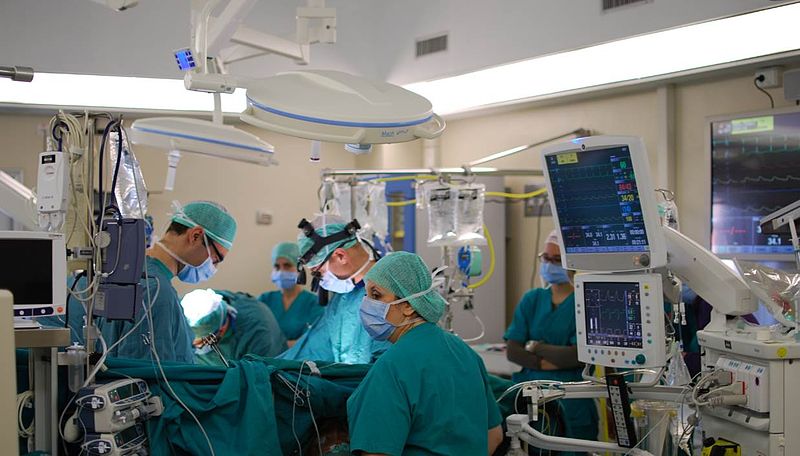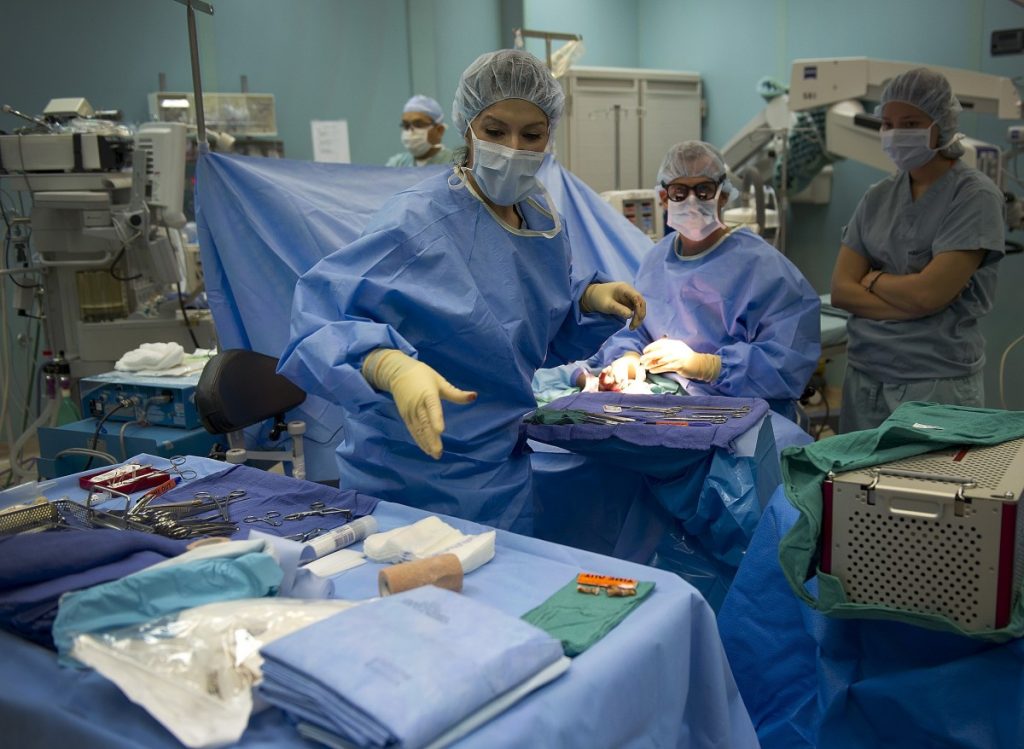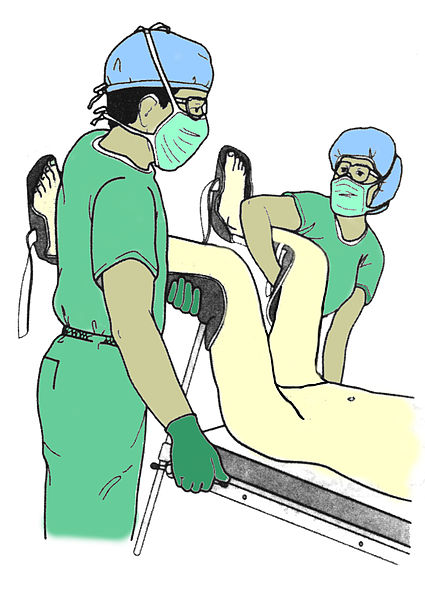2.4 Intraoperative Nursing Care
The intraoperative period is a critical phase in the client’s surgical journey, encompassing the time from when the client is wheeled into the operating room until they are transferred to the Post-Anesthesia Care Unit (PACU), Same-Day Surgery Suite, or Intensive Care Unit (ICU) following the surgical procedure. See Figure 2.5[1] for an image of intraoperative care. During this phase, nurses play a pivotal role in ensuring safety, promoting well-being, and advocating for the client.

In the intraoperative environment, nurses perform a wide range of essential tasks to provide comprehensive care to clients undergoing surgery. Nurses in the intraoperative environment must be highly skilled, detail-oriented, and capable of working efficiently in a fast-paced and high-stress setting to ensure the best possible outcomes for their clients.
One of the primary safety goals of nursing staff during the intraoperative period is to maintain a vigilant, safe, and controlled environment. They work collaboratively with the surgical team to confirm the client’s identity, verify the surgical site through a “time-out” procedure, and ensure all necessary equipment and supplies are readily available.
The surgical time-out is a safety procedure that includes a purposeful pause before all surgeries begin. It is performed to address one of The Joint Commission’s National Patient Safety Goals to reduce mistakes in surgery. During the surgical time-out, the entire operating room team reviews the client’s identity, the procedure, and the location of the surgical site to prevent wrong-site, wrong-procedure, and wrong-person errors. The time-out is also a time designated for team members to voice any concerns about the client’s safety or the procedure.[2],[3]
Monitoring
Nurses assist with continual monitoring and documenting of the client’s vital signs, anesthesia levels, and responses to the surgical intervention and assist with identifying the development of potential complications.
Ensuring adequate ventilation and oxygenation during surgery are essential for preventing respiratory complications and maintaining client safety throughout the intraoperative period. The nurse collaborates closely with the anesthesia provider to address any signs of hypoventilation promptly. Nurses continuously monitor the client’s vital signs, including heart rate, blood pressure, oxygen saturation, and respiratory rate, as well as the client’s breathing pattern and end-tidal carbon dioxide (ETCO2) levels, to detect any deviations from normal and to promptly address any changes to prevent hypoventilation. These assessments are typically documented every five minutes to detect any deviations from the baseline.[4]
Intraoperative Nursing Interventions
Intraoperative nursing interventions play a critical role in ensuring the safety and well-being of clients undergoing surgical procedures. Throughout the intraoperative period, nurses are actively involved in a range of essential tasks aimed at optimizing client outcomes and preventing complications. By diligently following established protocols and collaborating closely with the surgical team, intraoperative nurses contribute significantly to creating a safe and conducive environment for surgical interventions. The role of the intraoperative nurse is multifaceted and includes actions described in the following subsections.[5]
Setup and Maintain Sterile Fields
Nurses in the intraoperative scrub role help set up the sterile field in the operating room, ensuring that all necessary surgical instruments, drapes, and supplies are properly arranged. They ensure the integrity of the sterile field is maintained throughout the procedure to prevent contamination and minimize the risk of surgical site infections. See Figure 2.6[6] for an image of surgical instruments set up on a sterile field in the operating room.

Infection control measures are meticulously implemented to minimize the risk of surgical site infections such as scrupulous handwashing, absolute sterile technique, and personal protective equipment.
Advocate for the Client
Advocating for the client’s safety and well-being is a central responsibility of intraoperative nurses. They verify the client’s identity, surgical site, and presence of the signed informed consent form before the surgery begins. During the surgery, they ensure safety protocols are followed and facilitate communication among the surgical team members to ensure a safe and efficient surgical environment.
Nurses serve as the client’s voice when they are under anesthesia, advocating for their best interests and ensuring their rights and preferences are respected. This involves effective communication with the client’s family or designated representatives and conveying relevant information about the surgical procedure. The nursing staff also collaborates closely with the anesthesia team to effectively manage pain and discomfort, ensuring a smooth transition to the postoperative phase.
Position Client to Prevent Injury
Proper client positioning is crucial during the intraoperative period to prevent injury and optimize surgical access. Nurses play a vital role in assisting the surgical team in positioning the client safely. The nurse ensures the appropriate position is achieved and maintained throughout the surgical procedure, which may involve using stirrups or placing the client in a prone position to expose the surgical site adequately. Common surgical positions include supine, lateral, prone, Fowler’s, and lithotomy positions.[7] The lithotomy position enhances access to the pelvic organs. The client is placed on their back with their buttocks at the edge of the table and their legs abducted 30 to 45 degrees from the midline. The patient’s knees and hips are flexed to about 90 degrees and supported with stirrups or padded leg holders. See an illustration of the lithotomy position in Figure 2.7.[8] and additional information about other positions using the information in the following box.

Review common positions in the “Basic Concepts” section of the “Mobility” chapter in Open RN Nursing Fundamentals, 2e.
Careful attention is given to techniques to prevent postoperative complications associated with positioning, which can include nerve damage, pressure injuries, or musculoskeletal strain. Frequent assessments are also performed throughout the procedure to detect any signs of potential injury or discomfort, allowing for timely adjustments to maintain client safety and well-being.[9]
To prevent complications related to client positioning, nurses take measures to reduce pressure on vulnerable areas by using padding and gel pads to cushion bony prominences. Regular skin assessments are conducted to identify areas of potential skin breakdown or pressure injuries. By diligently applying these preventive strategies, the nurse aims to minimize the risk of pressure injuries and other complications related to client positioning.[10]
Assist the Surgeon
In collaboration with surgical technologists, nurses assist the surgeon by providing instruments and surgical supplies and anticipating the surgeon’s needs to maintain a smooth workflow.
Administer Medications
Under the supervision of the anesthesia team, nurses may administer medications, fluids, and blood products as required during the surgery.
Document Procedures
Accurate documentation is essential for proper client care and recordkeeping. Nurses document the details of the surgery, anesthesia, medications, and any significant events that occur during the intraoperative period.
Communicate With the Surgical Team
Effective communication among all members of the surgical team is crucial for seamless coordination. Nurses actively communicate with the surgeon, anesthesiologist, and other team members to ensure everyone is well-informed with consistent knowledge about the client’s status.
Nurses also collaborate with the surgical team to ensure that the surgical incision is closed securely, and drains are functioning properly. Vigilant monitoring of the wound site for signs of complications allows for early intervention and appropriate management.[11]
Handoff Care
As the surgical procedure concludes, nurses prepare the client for transfer to the postanesthesia care area, ensuring a smooth handoff of care.[12]
- “Cardiac_surgery_operating_room.jpg” by Pfree2014 is licensed under CC BY-SA 4.0 ↵
- Freundlich, R. E., Bulka, C. M., Wanderer, J. P., Rothman, B. S., Sandberg, W. S., & Ehrenfeld, J. M. (2020). Prospective investigation of the operating room time-out process. Anesthesia and analgesia, 130(3), 725–729. https://doi.org/10.1213/ANE.0000000000004126 ↵
- Johns Hopkins Medicine. (n.d.). Surgical team. https://www.hopkinsmedicine.org/health/treatment-tests-and-therapies/the-surgical-team ↵
- Salazar, A. M. (2022). Nursing care during the perioperative period within the surgical context. Investigacion y Educacion en Enfermeria, 40(2), e02. https://doi.org/10.17533/udea.iee.v40n2e02 ↵
- Salazar, A. M. (2022). Nursing care during the perioperative period within the surgical context. Investigacion y Educacion en Enfermeria, 40(2), e02. https://doi.org/10.17533/udea.iee.v40n2e02 ↵
- “US Navy 110825-N-EP471-069 Hospital Corpsman 2nd Class Amanda Fletcher assists Lt. Cmdr. Timothy Mickel as he performs finger surgery on a Haitian.jpg“ by U.S. Navy photo by Mass Communication Specialist 1st Class Kim Williams is licensed in the Public Domain. ↵
- Armstrong, M., & Moore, R. A. (2022). Anatomy, patient positioning. StatPearls [Internet]. https://www.ncbi.nlm.nih.gov/books/NBK513320 ↵
- “Lithotomy_position_01.jpg” by Saltanat ebli is licensed under CC0, Public Domain. ↵
- Salazar, A. M. (2022). Nursing care during the perioperative period within the surgical context. Investigacion y Educacion en Enfermeria, 40(2), e02. https://doi.org/10.17533/udea.iee.v40n2e02 ↵
- Salazar, A. M. (2022). Nursing care during the perioperative period within the surgical context. Investigacion y Educacion en Enfermeria, 40(2), e02. https://doi.org/10.17533/udea.iee.v40n2e02 ↵
- Salazar, A. M. (2022). Nursing care during the perioperative period within the surgical context. Investigacion y Educacion en Enfermeria, 40(2), e02. https://doi.org/10.17533/udea.iee.v40n2e02 ↵
- Benze, C., Spruce, L., & Groah, L. (2021). Perioperative nursing: Scope and standards of practice. AORN. https://www.aorn.org/docs/default-source/guidelines-resources/periop-nursing-scope-standards-of-practice.pdf?sfvrsn=c532cdee_1 ↵
The time from when the client is wheeled into the operating room until they are transferred to the Post-Anesthesia Care Unit (PACU), Same-Day Surgery Suite, or Intensive Care Unit (ICU) following the surgical procedure.
A purposeful pause before the procedure begins in which the surgical team confirms the procedure to be performed and the correct client.
Client is placed on their back with their buttocks at the edge of the table and their legs abducted 30 to 45 degrees from the midline

